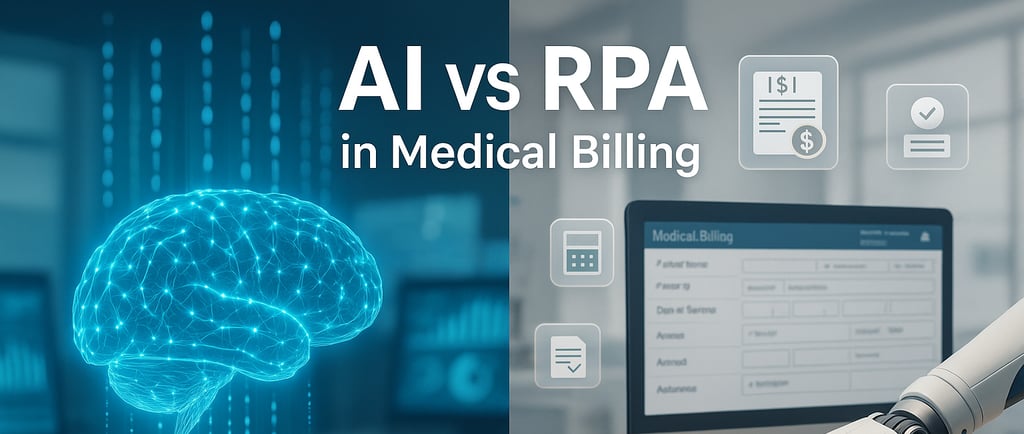AI vs RPA in Revenue Cycle Management: What Works Best in 2025?
Explore AI vs RPA in medical billing. Discover which drives better results for revenue cycle management in 2025.
4/20/20254 min read


Introduction
AI and RPA are transforming healthcare—but which is the smarter choice for revenue cycle management (RCM)? 🤖💡 According to a 2024 report by Black Book Research, 93% of hospitals are investing in automation to reduce billing errors and increase collection rates. That's a massive shift.
If you're a healthcare executive, billing specialist, or practice owner, you're likely asking: Should we invest in AI, RPA—or both?
In this article, we’ll compare AI vs RPA in medical billing, break down their core differences, examine use cases, and help you decide which one (or both!) is right for your RCM strategy in 2025.
Understanding AI and RPA in Healthcare Finance
Before we dive into comparisons, let’s define our contenders:
Artificial Intelligence (AI) mimics human decision-making through machine learning and algorithms. In medical billing, AI can analyze complex data, predict patient behavior, and detect anomalies.
Robotic Process Automation (RPA) follows set rules to perform repetitive tasks, like copying data from one system to another. It’s ideal for structured, manual work.
Both aim to streamline revenue cycle operations, reduce human error, and speed up workflows—but their methods and capabilities differ significantly.
Key Differences Between AI and RPA in Medical Billing
While both are automation tools, their functionality and scope set them apart:
FeatureAIRPACore FunctionLearns from data, makes predictionsExecutes rule-based, repetitive tasksData TypeHandles structured + unstructured dataLimited to structured dataDecision-MakingDynamic, adjusts with new inputStatic, based on pre-set logicAdaptabilityLearns and evolvesCannot adapt without reprogrammingSpeed to DeploySlower, complex setupQuick and easy to implement
Real-World Example:
An AI system might predict which claims will be denied based on historical data, while an RPA bot might simply file those claims according to a fixed rule set.
Strengths and Weaknesses of AI in Revenue Cycle Management
Strengths:
Excels at complex, high-volume data analysis
Learns over time, improving accuracy and speed
Identifies trends in denials and payment delays
Can personalize patient payment reminders based on past behavior
Weaknesses:
Higher upfront cost and implementation time
Requires clean and large datasets
Needs skilled technical support
Best Uses for AI in Medical Billing:
Predicting claim denials
Fraud detection
Analyzing payer behavior
Enhancing patient engagement and collections
Case Study:
A New York-based hospital used AI to cut denial resolution time by 40%, identifying root causes early and reallocating staff to more complex billing issues.
Strengths and Weaknesses of RPA in Revenue Cycle Management
Strengths:
Fast deployment with minimal disruption
Cost-effective for small to mid-sized practices
Reduces manual errors and boosts productivity
Doesn't require AI-level expertise to maintain
Weaknesses:
Limited to simple, rule-based tasks
Not ideal for handling unexpected exceptions
Doesn’t “learn” over time
Best Uses for RPA in Medical Billing:
Checking claim statuses
Posting payments
Extracting EOBs from payer portals
Automating data entry between EHRs and billing systems
Case Study:
A small Midwest clinic reduced manual entry time by 60% using RPA bots for claim follow-ups, freeing up staff for patient care.
When to Choose AI, RPA—or Both—for Your RCM Strategy
RPA is best if:
✅ You have a high volume of manual, rule-based tasks
✅ Your practice needs a quick win with minimal investment
✅ You want to avoid major IT overhauls
AI is best if:
✅ Your workflows involve unstructured data (notes, emails, EOBs)
✅ You need advanced analytics and forecasting
✅ You aim to scale your RCM processes intelligently over time
Best of Both Worlds:
Many organizations are turning to intelligent automation, where AI analyzes and guides, while RPA executes. For example, AI might detect trends in patient behavior and RPA acts on those insights by sending reminders or adjusting workflows.
Future Outlook: AI vs RPA in Medical Billing by 2025 and Beyond
The future of RCM is not just automated—it’s intelligently automated.
Key trends to watch:
Growth of AI-powered chatbots for patient billing queries
Integration of AI + RPA platforms for full-cycle automation
Increased regulatory compliance needs driving adoption
Tools with built-in predictive analytics for revenue leakage
As we move toward value-based care, billing systems need to be flexible, predictive, and responsive—traits that only
Conclusion
In the dynamic landscape of healthcare revenue cycle management, both AI and RPA have emerged as pivotal tools. AI offers advanced capabilities in predictive analytics, enhancing decision-making and identifying potential issues before they escalate. RPA, on the other hand, excels in automating repetitive, rule-based tasks, leading to increased efficiency and reduced errors.MBW
Integrating both technologies can lead to a synergistic effect, optimizing the entire revenue cycle process. By leveraging AI's analytical prowess alongside RPA's automation strengths, healthcare organizations can achieve improved financial performance and operational efficiency.
Frequently Asked Questions (FAQ)
Q1: What are the primary benefits of integrating AI into RCM?
AI enhances RCM by providing predictive analytics, identifying patterns in claim denials, and optimizing billing processes. This leads to improved accuracy, faster reimbursements, and better financial forecasting.Medwave Billing & Credentialing
Q2: How does RPA contribute to revenue cycle efficiency?
RPA automates repetitive tasks such as data entry, claims submission, and payment posting. This reduces manual errors, accelerates processing times, and allows staff to focus on more strategic activities.ProDevBase Technologies Pvt Ltd+3Quadax Blog+3247medicalbillingservices.com+3
Q3: Can small healthcare practices benefit from AI and RPA?
Absolutely. While larger institutions may have more resources, scalable AI and RPA solutions are available that cater to the needs of smaller practices, offering improved efficiency and cost savings.
Q4: What challenges might organizations face when implementing these technologies?
Challenges include initial investment costs, integration with existing systems, staff training, and ensuring data security and compliance with regulations like HIPAA.Medwave Billing & Credentialing
Q5: How do AI and RPA impact patient experience?
By streamlining billing processes and reducing errors, patients experience more accurate billing, faster resolutions to inquiries, and overall improved satisfaction with the administrative aspects of their care.
